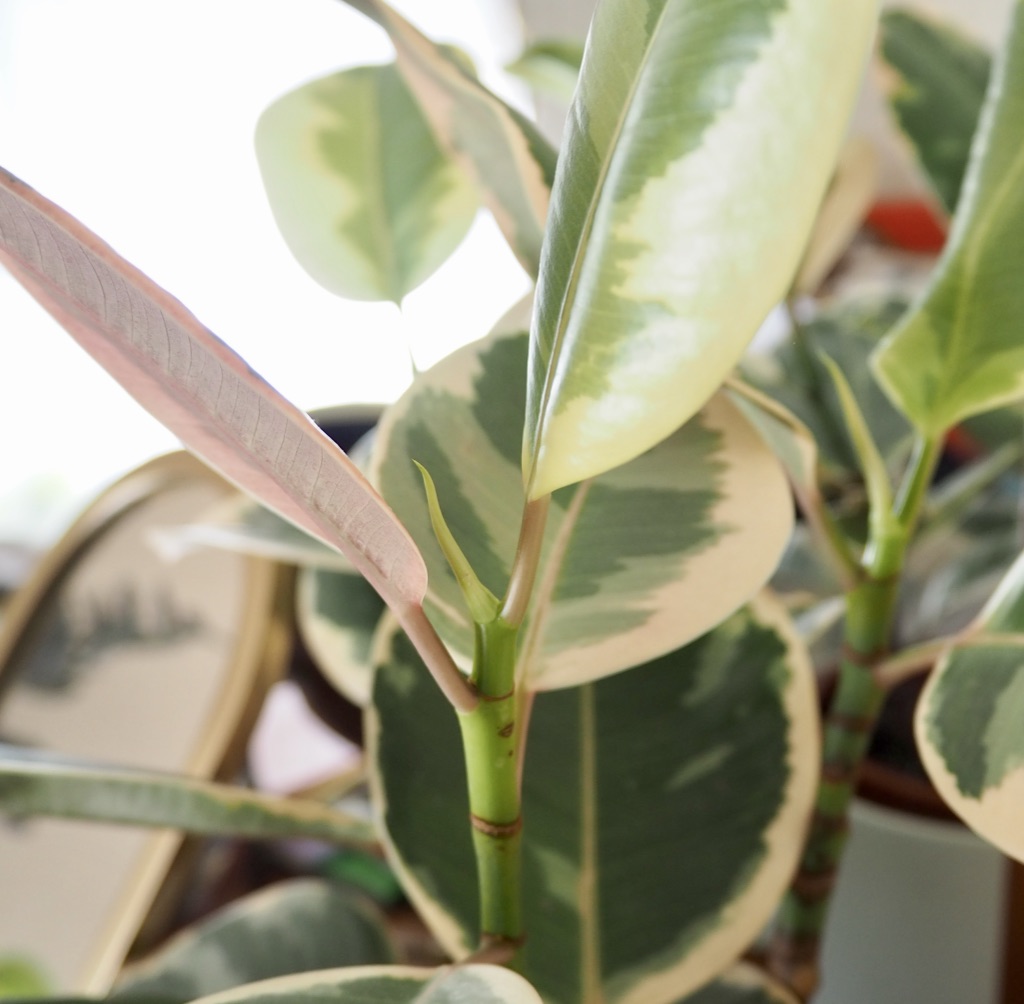Today I wanted to share a process that is easy to do but one that can be a bit daunting… cutting the top off ficus plants. It’s funny because I know I will go at my outdoor balcony plants with a snips way more readily than my houseplants! Pruning just seems an inherent part of outdoor gardening, but indoors, not so much (for me anyway). I have been getting better at this though, which is reflected in my ‘be-heading’ of (some of) my Ficus elastica as you see here. If you have been contemplating giving this a go, this blogpost should help.
Disclaimer: I do have a number of ficus plants… in fact, my ficus family count is now at 7… so I decided to carry out a bit of an experiment with three of my smallest plants, all of which are Ficus elastica tineke – aka variegated rubber plant. I will say that I do love how some of my larger single stem plants look in my apartment; they are tall, elegant + don’t take up much room. But I’d never had a multi-stemmed pot + instead of buying another plant, I thought I would attempt to make my own.
| W H Y ? |
The main reason for doing this is to create a fuller, more bushy looking plant, more akin to a tree with multiple branches.

Taller single stem plants can look a bit leggy after a few years, as ficus often drop some lower leaves (particularly over winter – more on this in an upcoming blogpost) + can start to look a bit sad + the base of the stem bare – multi stemmed pots can disguise this pretty well. Furthermore, if you are short on space, it might be a good option to pot a few plants together to create impact from one single pot.
| H O W ? |
The most straightforward method is to simply take a clean blade – sterilise it before use + to cut underneath a leaf node. The photograph below shows where I made the cut – above these points were leaves – I shared two with friends and discarded one that was looking a bit ropey. I left the cut end to seal over and rooted in water. For further reference, on the photograph above, the cut would be made where the green circle cuts across the stem in the image. On more mature plants you might choose to cut further down the stem, in which case, there will be more to remove – you can pop this cutting into potting mix (or water) + try to root it if you would like to make a new plant. Wait a few days for the cut to dry and seal over before putting in soil – the stem is likely to rot otherwise. Be warned, it’s a slow process especially if the stems are woody (like ficus can be).




A few weeks before cutting (in May 2019), I decided to pot two stems together and leave the other one in its own pot initially. Ficus can sometimes go into shock after repotting, so it’s best not to cut and re-pot simultaneously. In June I cut the tops of the three plants.

Then the practice of patience begins… I think the reason some people don’t take the plunge with cutting their stems (if they want to!) is that it can take considerably longer than other propagations. You certainly don’t get the almost-instant gratification of rooting a spider plantlet with this process! If you can, put your plants in a well-lit spot and almost forget about them (but obviously remember to water them!). I’m convinced my stems only started branching when I had almost given up hope…It is so exciting to see new growth starting to form – it is worth the wait! Three months later I noticed the first signs of new growth.
| W H E N ? |
The best time of year to do this is early Spring when the plants have a period of active growth ahead. I would not advise attempting this in Autumn or Winter as in cooler winter temperatures, the Ficus family can go dormant. Feeding the plants twice a month during Spring + Summer can help give the Ficus the best chance of success in this endeavour too + can speed up the process of new growth appearing.


Here is the update from March 2020 – each cut stem has settled in + grown three leaves each. One thing I love about a multi-stemmed pot is when the new leaves unfurl in-sync, it’s such a lovely thing to observe:



I hope you enjoyed seeing this process + that it has inspired you to give your ficus a chop this Spring if you have been considering it! Send me a photo on my Instagram and let me know how it’s going if you do. Best of luck!

I’m now contemplating giving my bambino fiddle leaf fig the chop next (above)… I’ll show you the process if I do it on my Insta Stories.


Leave a Reply